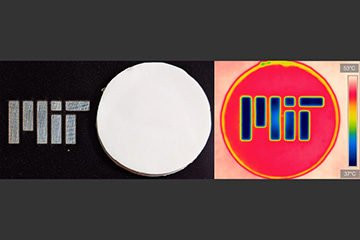
Polyethylene aerogel developed by researchers in the U.S. and Chile keeps objects cool by reflecting visible wavelengths (left) but transmitting in the infrared (right). [Image: Courtesy of the researchers]
Placing an object in the blazing sun and expecting it to cool down might seem like a tall order. But scientists in the U.S. and Chile have shown they can lower the temperature of items left outdoors on a clear day by as much as 13°C, thanks to a special insulating material made from a lightweight polyethylene foam (Sci. Adv., doi: 10.1126/sciadv.aat9480).
The researchers exploited the principle of “radiative cooling,” which relies on blocking solar radiation while emitting infrared heat, and which could allow perishable foods to be stored without electrical power as well as boosting the efficiency of refrigerators.
Harnessing a giant heat sink
Any object emits electromagnetic radiation across a range of wavelengths, but its emission spectrum has a peak determined by its temperature. It so happens that the atmosphere is transparent at wavelengths around the peak for an object at room temperature—between 8 and 13 μm. Given that space is in effect a giant heat sink with a temperature of just 3 Kelvin, it is in principle possible to cool an object down simply by exposing it to the open sky (see “Radiative cooling,” OPN, November 2019).
Carrying out this kind of cooling in practice, however, means being able to shield an object from incoming solar radiation (unless it is cooled exclusively at night). At the same time, it must be thermally insulated from its environment so that once its temperature drops below that of its surroundings it does not heat back up via conduction and convection.
Most schemes for radiative cooling to date have separated out these two functions. Researchers have developed a range of advanced materials that emit copiously in the infrared while largely deflecting radiation at shorter wavelengths—such as very thin sandwiches of silicon dioxide and hafnium oxide, or tiny balls of silicon dioxide inside a polymer film, both of which sit on top of a layer of silver. But those high-tech films still need to be insulated from the outside world, and this has been done using layers of wood, air and polyethylene, for example.
Reflection, emission and insulation
In the latest work, Evelyn Wang and Arny Leroy at the Massachusetts Institute of Technology (MIT), USA, together with colleagues at MIT and the Pontifical Catholic University of Chile, have combined all three aspects—solar reflection, infrared emission and thermal insulation—using a new form of polyethylene.
Previously, this material has come in the form of thin films, which are dense and therefore provide limited insulation if they are to remain transparent to infrared radiation. But Wang and her team have now recast polyethylene in the form of an aerogel—a porous solid with very low density and thermal conductivity that they made by carefully extracting the liquid solvent from a homogenous mixture of polyethylene and paraffin oil.
This polyethylene aerogel, which is almost all air, reflects more than 90% of incoming solar radiation while transmitting some 80% of the infrared waves that reach it. The aerogel serves as a cover for the object being cooled, known as the “emitter,” allowing the emitter to cool down far more than would otherwise be possible.
Aerogel versus the Atacama
Wang and colleagues tested the technology by setting up two radiative coolers side by side. Both devices contained an emitter consisting of a specular mirror made by the company 3M—multiple layers of polymers with different refractive indices to enhance reflection at certain wavelengths—mounted on a layer of polished aluminum. However, only one emitter was covered by the polyethylene aerogel.
Taking the two devices to the Atacama desert in Chile, one of the driest places on Earth, the researchers found that the temperature of the emitter covered by the aerogel dropped by 13°C when left out in the midday sun, while that of its uncovered neighbor fell by only 1.7°C. Similar tests carried out in the less intense light of Massachusetts yielded figures of 9.8°C and 1.1°C respectively.
According to Leroy, this is more cooling than has been achieved to date with any other passive radiative device (apart from ones that provide insulation via a heavy, expensive vacuum system or those that are shielded from sunlight). Possible applications, he adds, include keeping fruit, vegetables and other perishable foods fresh for longer in the absence of powered refrigeration. The technology might also serve as an initial stage for electrical fridges, making such devices more energy efficient.
Still, there is some way to go before this technique arrives at the theoretical maximum of roughly 50°C cooling below ambient temperature. Getting closer, the researchers write, might involve further optimizing the optical properties of the polyethylene aerogel or using other materials with potentially even better optical and thermal properties, such as barium fluoride or zinc sulfide. In addition, they say, improvements to theoretical modeling might allow a cover’s thickness and optical properties to be better matched to weather conditions as well as making devices cheaper.
